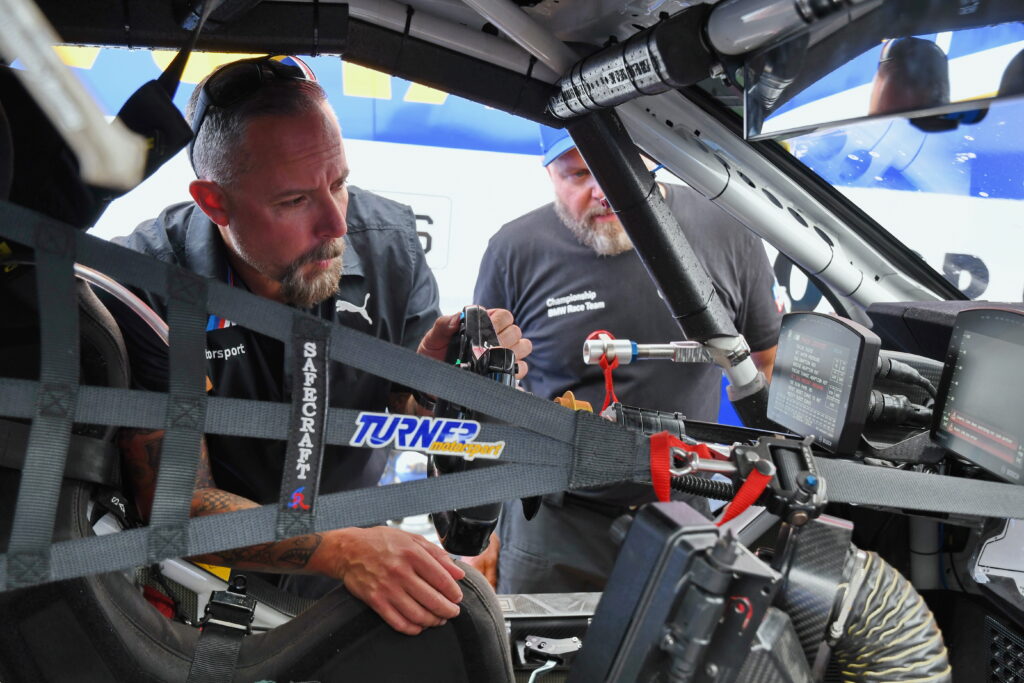By all accounts, the M4 GT3 is a well-developed and well-designed race car. It’s also very effective at winning races, having won several around the world in 2022 along with championships in the IMSA Sprint Cup Championship and DTM. There’s some cool tech behind the car, and some things on the car that you may wonder what they do. To explain some of these things a little better, we had BMW M Motorsport Race Support Engineer Dusty Renteria show us around the car.
Renteria is on hand every race weekend in both the IMSA and SRO series where the M4 GT3 competes and can be seen going back and forth among the BMW teams as he works with them to make sure the car is working at its optimum. He also supports teams that compete with the M4 GT4 and M2 CS.
Believe it or not, the M4 GT3 is a bit larger than the M6 GT3 it replaced, though it looks smaller. The hood of the M4 GT3 looks nothing like the road car, with big openings that you’ll see are filled with radiators if you look down through them. Renteria said that there are also two intercoolers in there (one for each turbocharger) that also benefit from the air circulation through the openings in the hood. The bodywork on the hood is also designed to help reduce lift on the front of the car as the air passes through them, as well as dissipate heat from going into the firewall.
A look at the radiators through the large hood opening.
One major difference on the M4 compared to the M6 is the exhaust: “On this car we have all the exhaust going out on one side of the car, whereas on the M6 GT3 it was a V8 so we had two exits,” says Renteria. “That makes it quieter for the driver and also more comfortable temperature-wise because you don’t have an exhaust exit near the footwell and driver compartment side of the car. But we do have an engine putting out 540 to 550 horsepower with one pipe, so there’s a lot of heat pushing out that one exhaust exit.” To help keep the heat down on that exhaust, there’s a duct in the hood that directs air at the exhaust pipe under the hood. There’s also plenty of venting around the exhaust pipe where it exits the car behind the front left wheel. If you look closely at the plate that’s welded to the exhaust pipe under the hood, you’ll see that it was built by Akrapovič.
The side exhaust has plenty of venting to keep heat down.
The air intake directs air at the exhaust pipe under the hood.
You’ll also see some strange-looking attachments on the M4 GT3 around the rear trunk area. Renteria explains that the vent attachment on the trunk lid serves two purposes. One side directs air to the differential oil cooler and the other side directs air at the air conditioning condenser. The strange looking hole that’s on the rear window shelf is an air conditioning intake that recirculates the cabin air for cooling. There’s also a cutout on the rear window with access points to add fluid for the clutch and master cylinder.
The intake on the trunk lid is used for the differential oil cooler and A/C condenser. The hole in rear shelf is to recirculate air for the A/C.
On the passenger side of the car next to the fuel filler hookup, there’s what looks like a small solar panel. Renteria explains that it’s actually a timer display for when the fuel rig is plugged into the car. “Most IMSA fill times are at 40 seconds minimum, but there are many instances (such as a short fill stop) where the fuel filling crewman can see how long he has been filling the car,” he says. The red plug to the right of the fuel filler is simply to plug a battery charger into, which is hooked up to almost all the time when the car is sitting in the paddock. Renteria said that’s needed because the data engineers usually have the car on even while it’s sitting still to check readings and data, and the car draws a lot of amperage when the power is on for that purpose.
The panel to left of the fuel filler is used to display fuel filling time. The red plug is for a battery charger hookup.
Renteria also talked us through some of the cool features on the car that are not readily visible. “We have a pretty clever system now for adjusting the ride height,” he says. “We have the ability to use shims that are pre-determined sizes to give a change in the ride height, which is super helpful. Before we were always adjusting the collars on the springs to raise or lower the car. Ride height also affects the downforce. Since we’re limited on how much we can change the rear wing angle with the homologation rules, a lot of engineers will run with lower ride heights at the back of the car to generate more downforce. It’s kind of a balancing act.” Much of the continued development work on the M4 GT3 is with the software. Renteria explains that there are software updates throughout the season to debug some things in the system and there’s also been some ABS updates.
The M4 GT3 will be in its second season of racing in 2023 and there are high expectations for the car after it had so much success in its debut season in 2022. The BMW will face stiff competition from the new Ferrari 296 GT3 and Porsche 911 GT3 R, as well as well-developed cars from Aston Martin, Lexus, Mercedes AMG, Acura and Lamborghini. —David Haueter
[Photos by David Haueter]
